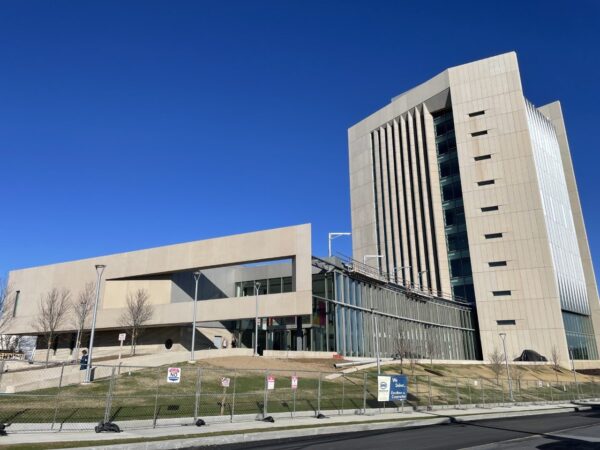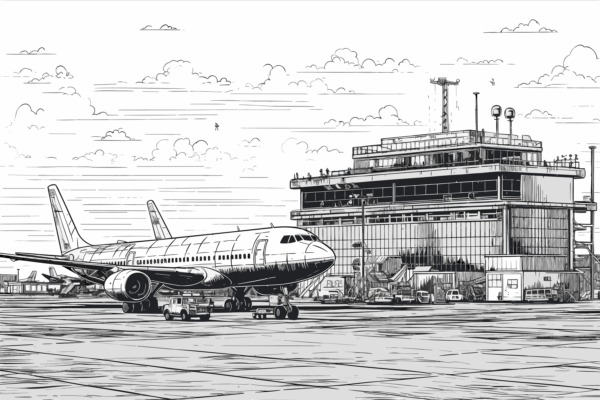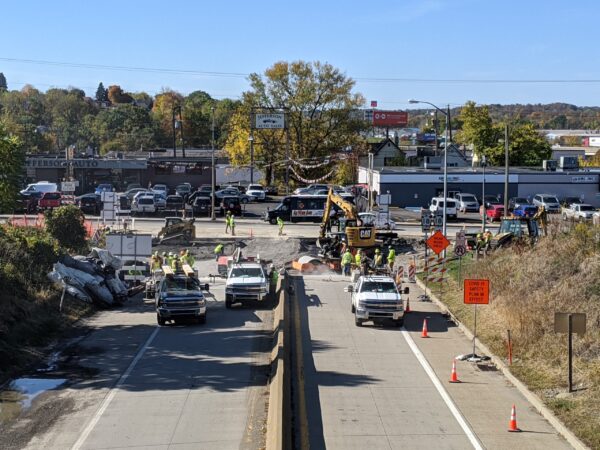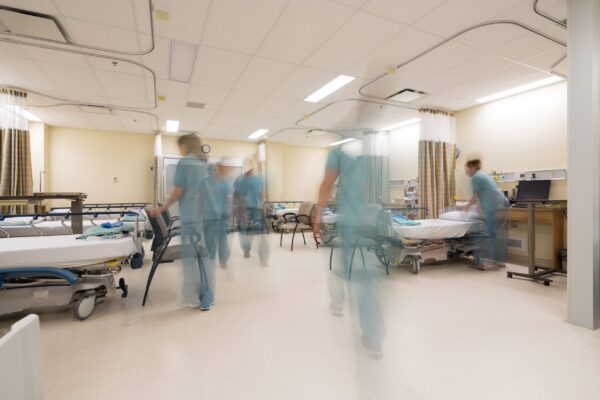

Work is underway in Cape May Courthouse, New Jersey, on a new county jail that will ease overcrowding, help the county meet tightening state and federal corrections standards, and realize significant cost savings with a more efficient building that is safer to operate.
The Cape May County Jail is one of 21 county jails in New Jersey. It was built in 1976 to house 168 inmates. Today, at 45,589 square feet, the one-story jail houses an average of 240 inmates per day. In the summer in this seaside county, the jail’s daily population can spike to more than 300. Since most detainees are awaiting trial, their average stay is 17-20 days. Although some inmates may stay longer, none are allowed to remain for more than 364 days.
Like other jails throughout New Jersey and the nation, Cape May County Jail is under federal mandate to expand and modernize its facilities. The cells no longer meet federal standards. At 30 to 35 square feet, the forty-year-old cells are now half the required size of 70 square feet. Overcrowding often leads to three inmates occupying a cell built for two. The jail’s plumbing, electrical and HVAC systems also are aging, and need near-constant attention by county staff to keep them in good order.
Cape May County has been weighing suitable, cost-effective options for either rebuilding or closing the jail for the past decade, said Freeholder Director Gerald M. Thornton. “We’ve been scrambling to correct the situation. It’s a safety factor for the inmates and for the corrections officers,” he said.
The choices considered included new construction, a just-as-costly renovation, and closing the jail entirely and relying on other jails within the state to house the county’s inmates—while Cape May County continued to foot the bill for its inmates’ incarceration, transportation and medical needs.
Bids to renovate the jail solicited four years ago totaled more than $29 million, and still would not have made the jail fully compliant, Thornton said. He and his staff remember well the meeting when the renovation price was unveiled. “I wasn’t happy,” Thornton said. “We were talking about spending $29 million and would, in the end, still not be compliant; the jail would still be too small? You need a specific amount of square footage per inmate, and the existing footprint would never have worked.”
Closing the jail and moving inmates elsewhere, along with the inherent housing, medical and transportation costs, still would have cost the county $12 million a year.
Doing nothing wasn’t cost-effective, either, said AnnMarie McMahon, Director of Facilities and Services. McMahon oversees some 100 county buildings on more than 250 acres, including the jail. The jail, she said, costs about $500,000 a year to maintain, and far outweighs the other facilities in terms of the attention it requires every day. Most of the repair issues involve the jail’s plumbing and utilities, added county Director of Operations Michael Laffey.
In addition, while the county has been praised for its maintenance of the aging masonry facility, its timeline for compliance with current state and federal regulations was running out. “Federal judges don’t look kindly on jails that don’t comply,” said Warden Donald J. Lombardo. Lombardo oversees inmates and a staff of nearly 90 at the facility.
The county made the decision to build a new jail next to the existing one, at the county’s expansive governmental complex in Cape May Courthouse. Work began in late summer, and is expected to be completed in the summer of 2019.
The new jail will not only provide more space for inmates; it also will contain a new, much larger medical facility that will allow the jail’s 24-hour healthcare staff to handle a variety of illnesses on-site. Increasing numbers of prisons and jails across the country are opting for on-site medical care whenever possible, and making sure they have the facilities to provide it. On-site care improves inmates’ overall health and wellness, and saves time, money and personnel required to securely transport inmates to hospitals and guard them while they’re there. “Two corrections officers are required to be with an inmate at all times,” Lombardo explained. In addition, a higher level of medical care at the jail means that inmates can be released from hospitals sooner.
“Strictly in terms of overtime hours for corrections officers, we’re spending about 900 man-hours per month on inmates’ healthcare needs and trips to the hospital,” Lombardo said. “The medical unit will enable inmates to receive on-site care for such chronic illnesses as diabetes, cardiac issues, and Hepatitis-C,” Lombardo added. “We’ll also be set up to handle inmates with mental illnesses as well, so inmates who are suicidal will have a safe space in which to be evaluated and monitored, and won’t need to be transported to a hospital.” Lombardo estimates that as many as 60 percent of inmates have some form of mental illness. That figure aligns with state and federal statistics, which estimate that more than half of all inmates in state or federal prisons have some type of mental illness. In county jails, that number can reach 70 percent or higher.
The new jail will be designed to make processing of inmates—from their first entry onto the site to their cell assignments—easier and more efficient. “Processing will be seamless,” Lombardo said, eliminating the risk to both new inmates and corrections officers as new inmates move through the jail. “Anytime you move an inmate, even within the jail, it creates an opportunity for problems,” he explained. “With the new design, the processing may be the beginning and end of an inmate’s movement [through the entire facility], unless he or she is going to court.”
Once processed, inmates will move to cells that are grouped in self-contained units that include common areas for eating, relaxation and recreation—and constant supervision by teams of corrections officers assigned to each unit. “The design is based on the theory of direct supervision, where officers are in units with the inmates. Inmates are grouped in multiples of 64, and units are located along a central corridor that provides a good line of site to all areas,” Lombardo explained. “Being right there will eliminate a lot of problems. The corrections officers will know what’s going on at all times, because they’ll be right there. They’ll be able to build a rapport with the inmates, and the corrections officers will feel safer as well,” he added.
Now, corrections officers are headquartered in a command center located at the “center” of the facility, and hallways with cells extend out from the command center like spokes on a wheel. The new jail’s design breaks inmates up into smaller, more manageable groups of 64 that can be more easily observed, without the corners and inherent blind spots the current jail contains.
The self-contained units also mean that problematic inmates or alleged gang members can be more easily separated from the general population or other gang members. Inmates also won’t be able to use windows or the open outdoor yard to surreptitiously communicate with allies. The new modular cells won’t contain windows, and a common recreation area will now be housed indoors. Ceiling-height portals will let in ample natural light to both cells and common areas, McMahon explained.
Locating the recreation area indoors also will eliminate the jail’s problematic proximity to an adjacent veterans cemetery. “The new jail will allow inmates to get the recreation they need without disrupting cemetery visitors,” Lombardo said.
In addition, the new facility will provide more room and a completely separate area—using the same self-contained design—for the jail’s female inmates. (The jail now houses about 50 women in an area originally built to hold 35. The new jail will be able to accommodate up to 64 women.)
To help the new jail pay for itself, the facility will include a large laundry, which will service the jail and other county facilities, including the Crest Haven Nursing and Rehabilitation Center and the county Animal Shelter and Adoption Center. In addition, if the number of inmates drops, space at the jail can be rented out to other counties, to the U.S. Immigration and Naturalization Service or to the U.S. Marshal’s Service.
The new jail also will be both hurricane-resistant and its site built up to protect it from tidal flooding. (Cape May County, which borders the Atlantic Ocean and includes notable seaside tourist destinations such as Wildwood and Cape May, has weathered numerous Nor’easters and hurricanes, and has been lauded for its efficient emergency response and evacuation procedures. Notably, before Hurricane Irene in 2011, Cape May County Emergency Management moved a record 1,400 elderly from Crest Haven and five other long-term care facilities to higher ground. “It was—and remains—the largest long-term healthcare facility move in the United States to-date—without a single injury,” Thornton said proudly. The move was so well executed that a delegation from a flood-prone province in China visited to learn how it was done, Thornton added.)
Modular construction is helping to shave millions off the construction cost. The old jail was built of hollow concrete block, with utilities, HVAC and furniture, fixtures and equipment installed after construction. Modular pre-cast concrete units, however, are built at the factory with all furnishings and systems tie-ins already installed. “Each cell contains HVAC, plumbing, a toilet, sink and bed. When it’s placed on-site, the room is already there,” said Vincent J. Pawlowski, a Hill International Senior Construction Manager who is helping the county oversee and manage the project. The modular units have been used in increasing numbers by jails like Camp May County’s. “They allow for better quality control in terms of construction,” McMahon said.
Because modular units are built in a controlled environment, issues such as weather and temperature don’t hamper their construction. “On a typical construction site, you’re dealing with weather-related issues, but the factory provides much more stable conditions. So, the project can move along much faster than with poured-in-place concrete or CMU (concrete block), and that time savings translates to cost savings,” Pawlowski said. “And, the use of pre-cast concrete saves on the total cost as well.”
The county also negotiated a project labor agreement with local trade unions. Project Labor Agreements preserve union participation on construction projects while setting parameters on wages, overtime, work stoppages and other matters, McMahon said.
Once the modular units have been delivered, union trades will be on-site to join the units together into the facility’s electrical, plumbing, HVAC and security systems.
Once the new jail is completed and fully tested, and inmates and staff moved in, the existing jail will be demolished.
Although units are being assembled off-site, the project still will require careful planning, as it is proceeding next to—as close as 30 feet from—a fully operational jail, Pawlowski said. All mechanical systems must function around the clock—without interruption during the two-year project. Inmate transport, shift changes, deliveries, site visits and other daily occurrences also can’t be interrupted. Conversely, deliveries of construction materials and heavy equipment, as well as other activity at the site also must happen on time, and work must proceed as unfettered as possible. It’s a balancing act that Pawlowski knows well. He has assisted with Hill’s work at other area jails and prisons, including the construction of the maximum security S.C.I. Phoenix in suburban Philadelphia. He’s also assisted with the mammoth safety and security issues that working at a jail presents. Workers are pre-screened and undergo background checks before they’re allowed on-site. Deliveries are carefully scheduled and screened upon arrival, and public access to the existing jail will be carefully monitored to preserve security on the adjacent job-site.
The project’s special security needs make a coordinated and collaborative project team all the more important, Pawlowski said. He communicates daily with McMahon and the county staff so that everyone knows what challenges the day will bring and how they’ll confront them.
McMahon said that she and her staff appreciate the collaboration. “There are a lot of moving parts, but the project is progressing very smoothly,” she said.
Thornton is pleased as well. He knows full well that the new jail wasn’t everyone’s favorite capital project. Some critics would rather see county money spent elsewhere.
“The people of this county elected us to make tough decisions like this. No elected official wants to build a jail and spend $37 million to do it. But, they elected us to make these kinds of tough decisions, and we’ve done everything we can to make sure that this jail is being constructed as cost effectively as possible,” Thornton said. “We’ve looked at this from every conceivable angle. I have no qualms about this decision. It’s the right one.”
“By building the new jail, we’ll meet all of the requirements of the New Jersey Department of Corrections and the courts,” Thornton continued. “We’re protecting ourselves and protecting the people [who will govern] behind us.”
Lombardo agreed. “It all comes down to safety and security. We decided that, if we’re going to be in the jail business, we’re going to do this the right way,” he said. “This is the right way.”
Construction work is being completed by Hall Construction Co. Inc. of Farmingdale, NJ and the design was by L.R. Kimball a division of CDI-Infrastructure, LLC.
by Tricia M. McCunney, Hill International, Inc.
Share

April 11, 2024 | Articles
A Model Move: Managing Move-In at the Sylvia H. Rambo U.S. Courthouse

April 8, 2024 | Articles

April 4, 2024 | Articles
Driving Growth and Seizing Opportunity: Lukasz Marcinkiewicz Joins Hill as Country Manager, Poland

April 1, 2024 | Articles

March 27, 2024 | Articles
Building the Future: Women’s Leadership and Community Engagement in the Construction Industry

March 25, 2024 | Articles
Leveraging Data Analytics and Dashboards for Enhanced Project Performance

February 26, 2024 | Articles
Continuity, Creativity, and Collaboration: Delivering PennDOT’s Route 18 Signal Upgrade
We and use cookies and other tracking technologies to improve your experience on our website. We may store and/or access information on a device and process personal data, such as your IP address and browsing data, for personalised advertising and content, advertising and content measurement, audience research and services development. Additionally, we may utilize precise geolocation data and identification through device scanning.
Please note that your consent will be valid across all our subdomains. You can change or withdraw your consent at any time by clicking the “Consent Preferences” button at the bottom of your screen. We respect your choices and are committed to providing you with a transparent and secure browsing experience.
| Cookie | Duration | Description |
|---|---|---|
| cookielawinfo-checbox-analytics | 11 months | This cookie is set by GDPR Cookie Consent plugin. The cookie is used to store the user consent for the cookies in the category "Analytics". |
| cookielawinfo-checbox-functional | 11 months | The cookie is set by GDPR cookie consent to record the user consent for the cookies in the category "Functional". |
| cookielawinfo-checbox-others | 11 months | This cookie is set by GDPR Cookie Consent plugin. The cookie is used to store the user consent for the cookies in the category "Other. |
| cookielawinfo-checkbox-necessary | 11 months | This cookie is set by GDPR Cookie Consent plugin. The cookies is used to store the user consent for the cookies in the category "Necessary". |
| cookielawinfo-checkbox-performance | 11 months | This cookie is set by GDPR Cookie Consent plugin. The cookie is used to store the user consent for the cookies in the category "Performance". |
| viewed_cookie_policy | 11 months | The cookie is set by the GDPR Cookie Consent plugin and is used to store whether or not user has consented to the use of cookies. It does not store any personal data. |


